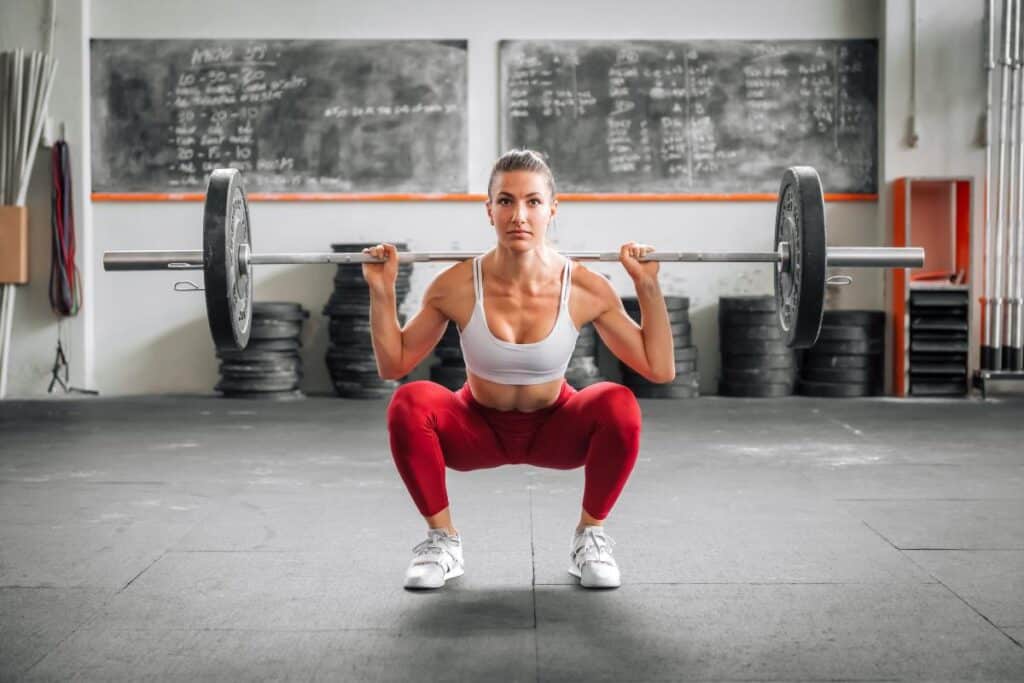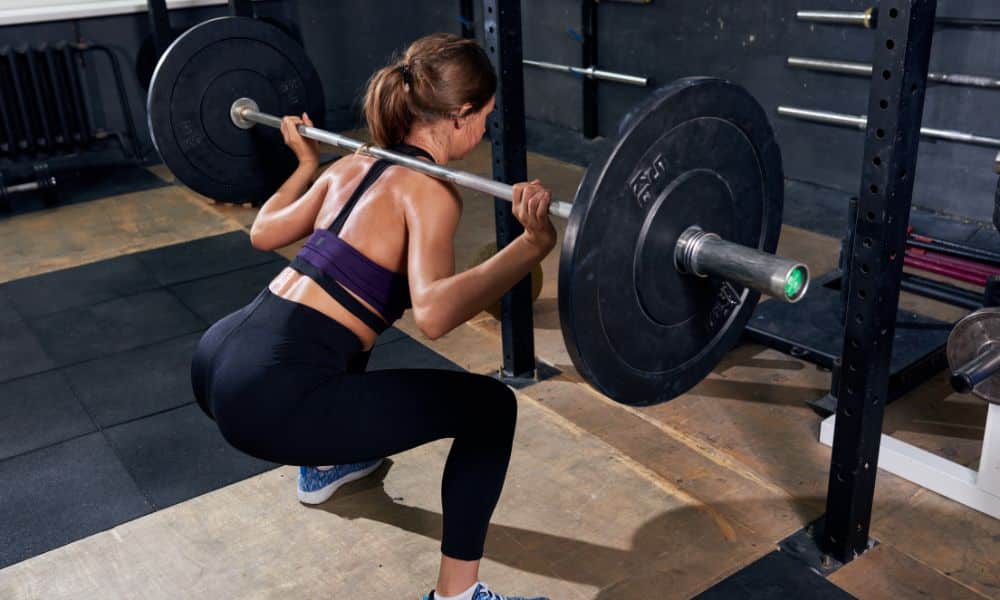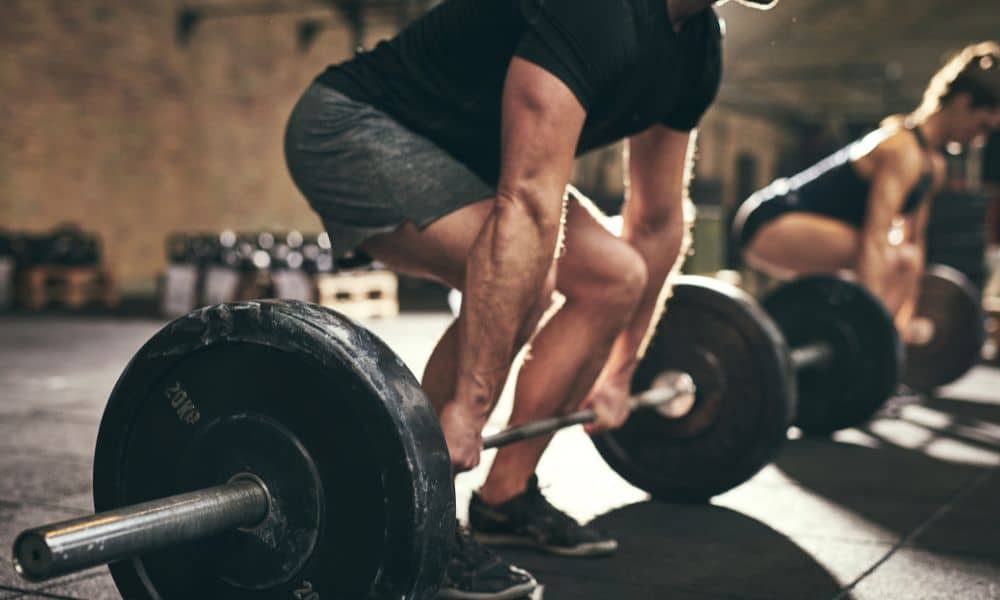How do you squat heavier weights to build a powerful physique? Despite the myth that squats are dangerous, they regularly make powerful quadriceps, hamstrings, and butt. Also, it boosts knee stability, activates testosterone and human growth hormones, and regenerates connective tissue by forcing it to become sturdy.
Squatting is a basic human movement you can do with varying difficulty and complexity. Bodybuilders perform the squat with a weightlifting barbell on the back. Still, you also do it with other weights, including kettlebells, dumbbells, TRX suspension straps, machines, resistance bands, walls, and sandbags.
In addition to the type of resistance you can use, there are also many types of squats, such as the back, front, hack, wall, cossack, and goblet.

How do you squat heavier weights?
To squat heavier weights, you start with the right gear. Wear comfortable clothes and the right shoes, gloves, and a weightlifting belt. Also, ensure you wear the belt correctly to support your core, not your lower back.
Next, focus on form when performing the squat. You want to make sure you are working the correct muscles. The proper form is vital when performing compound lifts to prevent injuries and work the right muscles. Compound lifts activated large muscle groups. The worst thing you can do is perform compound lifts with weaker, smaller muscles like the lower back.
Next, you will need a good workout plan that builds the primary and secondary muscles that perform the squat. Thus, you must do leg extensions, leg curls, deadlifts, and good mornings to ensure your legs, glutes, abs, and lower back are strong enough to lift heavy on the squat.
Next, you must incorporate progressive overload and a periodization plan to grow your muscles and lift heavier weights. By slowly lifting more each week, you will see better results. Progressive overload involves increasing the weight, sets, or reps. Using a periodization plan, you can incorporate a d-load week that ensures your muscles stay healthy and rested to lift more weight.
Finally, use a high-protein diet that you support with the right supplements. Protein powder, creatine, BCAA, glutamine, and other supplements can increase energy and strength. Building muscle and power is not magic but science. When you take the right approach, you get the best results.
What are some benefits of performing the squat correctly?
The squat is a versatile exercise targeting several muscle groups, including the glutes, quads, hamstrings, and calves. Properly squatting can help build muscle mass, increase strength, and improve overall mobility. Here is a list of some benefits that a squat provides:
1. Creates Anabolic Effect
Perform high-power resistance exercises if you want an acute anabolic response (steroid-like). Squatting heavier weights to build a powerful physique promotes testosterone and human growth hormone production. In addition, no other weightlifting exercise improves overall muscle growth.
Squats build muscles – quadriceps, hamstrings, and calves. It also activates muscle growth throughout your body. In addition, researchers conducted a 2010 study that found barbell squats contribute to anabolic hormonal responses and partially explain the muscle hypertrophy observed in athletes who regularly lift.
Lower body heavy resistance training creates testosterone (T), human growth hormones (HGH), insulin-like growth factor (IGF-1), and cortisol (C). Subsequently, a 2018 study found that six sets of squats cause HGH, C, and IGF-1 hormonal responses, which may play a crucial role in stimulating muscle growth and tissue regeneration. Performing 6 to 12 sets increased post-exercise HGH and decreased IGF-1 and C. The study also found that low-volume lifting is the limiting factor in increased post-exercise hormone secretion.
Effectively squatting heavier weight causes a hormonal response, so scientists use it almost only when testing how hormones respond to resistance training.
2. Improves mobility
Squatting amplifies your range of motion when you complete a full range of movement on the lift’s concentric and eccentric portions. The hips moving below the knees on the lift’s eccentric part identify a deep squat. Your mobility improves as you get through this full range of motion. Researchers at Ball State University remind us that leg strength is critical for maintaining mobility as you age. There is no better exercise for preserving and improving leg strength and creating a more robust physique than squats. This exercise also helps you to lift heavier on other activities.
Choose free weights over the Smith machine. A 2009 study compared free-weight squats to the Smith machine using electromyography (EMG). The study aimed to determine whether the free weight or Smith machine was best for activating the legs’ prime movers and the legs and trunk stabilizers. The study concluded the EMG average overall muscles during the free weight lifts were 43% higher when compared to the Smith machine. In addition, free weights are more helpful in strengthening plantar flexors, knee flexors, and knee extensors. The knees and ankles are not sexy, but they control your lower body mobility and range of motion.
3. Increases Functional Strength
There is a strong correlation between squatting heavyweight and functional strength. Since the beginning, people have been squatting to pick berries, gather food, light fires, and even cook. There is no question about it; the exercise builds functional strength, mobility, and a powerful physique.
A 1998 study concluded that squats with a 5-Rest Max (RM) load improve power performance. Athletes who squat train increase their vertical jump by 30 percent in eight weeks or fewer! Add squats to your workout program to run faster, jump higher, and become more mobile. Researchers scientifically proved that individuals who squat more jump higher, run faster, and have bigger muscular, fine-tuned legs, hips, and butts.
Subsequently, a 2004 study concluded that half squats’ maximal strength determines sprint and jumping performance. So let’s repeat it if you want to be faster, more explosive, and more powerful, then rack it up and see how much you can power up.
4. Activate Core Muscles
Squats are not just for your legs; they also require tremendous core stability to execute. Heavy squatting can strengthen your base quicker than core-specific training. In addition, squats are a great way to work your core muscles. They force you to engage your abdominal muscles to stabilize your body when you squat. Also, this helps to strengthen and tone your core muscles. Squats also help to improve your balance and coordination.
There are a few key reasons to use a weightlifting belt for squats. First, a belt can help you maintain proper form and posture throughout squatting. Second, it can help support your abdominal and lower back muscles, providing them with added stability and helping to reduce the risk of injury. Finally, a belt can help you move more weight safely and effectively, making the most of your workout.
A 2017 study found that 6-RM back squats resulted in greater erector spine activation but similar rectus abdomens and oblique external activation as the prone bridge. In addition, the study concluded that you could target core muscles by integrating high-resistance exercises like the squat instead of isolated and isometric core exercises.
What are the optimal repetitions, sets, training load, and rest time to squat heavier weights, build a powerful physique, and cause muscle hypertrophy?
The optimal reps to create massive muscles are 6 to 12 repetitions. Researchers showed it wipes out the ATP-CP energy source and challenges the Glycolytic energy source. You can never build large muscular muscles without challenging the glycolytic energy pathway. When your body is continuously low on glycogen, it is at the muscle and used by the muscle. The body responds by building larger muscles that can hold large glycogen cells.
The optimal set to create massive muscles and a powerful physique is 3 to 6 sets. However, most studies recommend six sets, as this article mentioned earlier. The sets are crucial because the body can replenish glycogen. Glycogen burns quickly, but the body refills it slowly, usually replenishing it at a drip rate of two to five percent per hour after exercise.
Empty glycogen stores can take a full day or more to restore. Finally, you determine your sets by what you can do. For example, if each set requires 12 repetitions and you cannot complete set 5 at 12 repetitions, you have three options: decrease the training load, repetitions, or sets. Reducing the sets is your best bet because you need the reps and training load for hypertrophy and want to complete the rest of your workout.
It would be best to base your optimal training loading on your 1-RM. The reps, sets, 1 -M, and training loads correlate and create a cause-and-effect relationship between weightlifting and big muscles.
The optimal rest time between sets is 30 to 60 minutes. But, unfortunately, the rest time is when most people fail miserably.
Seriously tracking your rest time allows you to use energy in a way that causes changes to your body. ATP-CP energy and oxidative energy are why you must take your rest time seriously. You only have a short supply of ATP-CP, but once used, it replenishes. The more you rest, the more it fills. As a result, ATP-CP provides strength and power.
In contrast to ATP-CP, you have an abundant supply of oxidative energy. Therefore, the less you rest, the faster your body switches to the oxidative energy pathway. As a result, the oxidative energy pathway burns body fat.
When you hit the sweet spot, just the right amount of rest time (30 to 60 minutes), your body switches and continues to use glycolytic energy throughout your workout. The glycolytic energy pathway causes muscle growth and a powerful physique. Take your rest times seriously because, just like your form, rest time can sneakily undermine your goals.
You get bodybuilding’s holy grail when you multiply your reps, sets, and training load. Think of your training volume as your final grade. It defines correctly using your reps, sets, training load, and rest time. If you cheat or maximize the process, your training volume and muscle size will follow.
Play with your reps, rest, sets, and training load. If you want a better idea of what to do with your training volume, time your workout from start to finish, and discover your training volume per minute. You can do this by dividing your total training volume by the minutes of your workout. Also, this allows you to compare apples to apples and see if you are making progress or cheating.
The best approach to squatting heavier weight is controlling the weight and staying mentally focused while performing the exercise.
Here is the right way to do a squat:
Start with the basics. The first thing you must do is to stand the right way. Stand with the bar on your upper back and keep your feet parallel, at shoulder width. Keep your toes pointed 30 degrees outward.
How deep can you go? Go down slowly so that your thighs are parallel to the ground. Also, push your knees to the side while moving your hips back. Break parallel by squatting down until your hips are lower than your knees. Many people can’t squat heavier weights to the correct depth because they lose balance. Practice without weight and watch your form in the mirror. The deeper you squat, the more muscles you activate and engage in the lift.
Keys to Squatting
Squatting is easy to learn, but some key things to keep in mind when performing them. First, keeping the back straight and the chest up is crucial. Second, squatting should be done with a full range of motion, meaning that the hips should descend below the knees before returning up. Third, squat at a slow and controlled pace. Fourth, breathing is essential when squatting, and exhaling should occur as you ascend with the squat.
Performing squats correctly can be a great way to improve overall fitness and body composition, and you can safely incorporate them into any workout routine. Squatting has many benefits, making it an essential exercise for anyone looking to get in shape and build muscle.
Pause and collect your thoughts before pressing your feet to the ground and thrusting your legs and hips up and forward.
Like a rocket, squat back up while keeping your knees out and chest up. Stand with your hips and knees locked at the top. When you perform each lift correctly, your legs will feel violated! Keep your heels on the floor. When you lift heavier weights, your heels must never leave the ground.
Control the weight. Don’t let the weight control you! If you feel off-balance, the weight is in control, not you. Everyone wants to squat heavier weight, but there is no shame in moving to a lighter weight. Look at it this way; your setback is only a setup for your comeback! Many lifters choose heavier weight over excellent form, one of the top reasons they can’t build a more powerful physique.
Mastering the Squat: Building Muscle and Targeting Belly Fat – Your Questions Answered
Squatting is a fundamental exercise with profound benefits, from building muscle mass to enhancing core strength. It’s a topic surrounded by queries, particularly concerning muscle building and fat loss around the stomach area. This Q&A session addresses the most searched questions online, offering evidence-based answers.
Q1: Can squatting really help build muscle?
A1: Absolutely. Squats primarily target the quadriceps, hamstrings, and glutes. However, they also engage the core, lower back, and even the upper body, making them an excellent compound exercise for muscle building.
Q2: How often should I squat to see muscle growth?
A2: For muscle growth, aim to squat 2-3 times per week. This allows for ample recovery time, which is crucial for muscle repair and growth. Consistency and gradually increasing the weight or volume will lead to noticeable gains.
Q3: What type of squat is best for building muscle?
A3: Back squats, where the weight is held across the upper back, are typically best for building overall muscle mass due to the ability to load heavier weights. Front squats are also effective, especially for targeting the quads and core.
Q4: Can doing squats burn belly fat?
A4: While squats are not a spot-reduction exercise and you cannot target belly fat specifically, they can help reduce overall body fat when performed consistently and combined with a balanced diet.
Q5: How can squats help in a fat-loss program?
A5: Squats increase your muscle mass, which boosts your resting metabolic rate, meaning you’ll burn more calories even when not exercising. This metabolic increase aids in overall fat loss when coupled with a caloric deficit.
Q6: What is the proper form for a squat to ensure effectiveness and safety?
A6: Proper squat form includes feet shoulder-width apart, chest up, back straight, and lower body sinking as if sitting in a chair. The knees should remain in line with the feet, and the hips should go back and down, keeping the weight on the heels.
Q7: Is there a recommended number of squats per session to maximize muscle growth or fat loss?
A7: There isn’t a one-size-fits-all number. However, for muscle growth, working in the range of 6-12 reps for 3-5 sets is common. For endurance and fat loss, higher reps (15-20) with more sets may be beneficial.
Q8: Can I do squats every day?
A8: Daily squats can be done, focusing on bodyweight squats for endurance. However, for strength and muscle building with heavy weights, rest days are vital to prevent overtraining and injury.
Squats are a versatile exercise that can help build muscle and contribute to fat loss, including the stubborn belly area, when incorporated into a comprehensive fitness routine. Remember, form and consistency are key, as is a balanced diet to support your fitness goals.
The last word on how to squat, heavier for a powerful physique
Squatting heavier weights is a common goal for many gym-goers who wish to develop a powerful physique. Also, squats are a great way to maximize your gym time. However, using the correct form when lifting is essential to achieve a heavy squat. Squatting using an excellent form is vital to lifting heavier weights and preventing injuries. This guide has outlined how to squat heavier weights while avoiding injury. Following the tips outlined in this post ensures your squats are as effective as possible.
Always use a spotter when attempting new weightlifting goals, and focus on your breathing throughout the lift. Also, use a weight that challenges you but doesn’t cause you to lose proper form–safety should always be your number one concern when squatting. Are you ready to put these tips into practice and see how much weight you can squat?
If you love bodybuilding, share this article on Facebook or Twitter so that others can learn more about building muscle.




